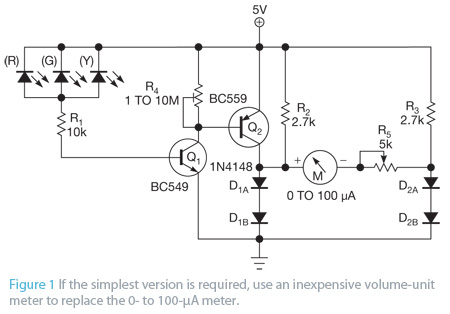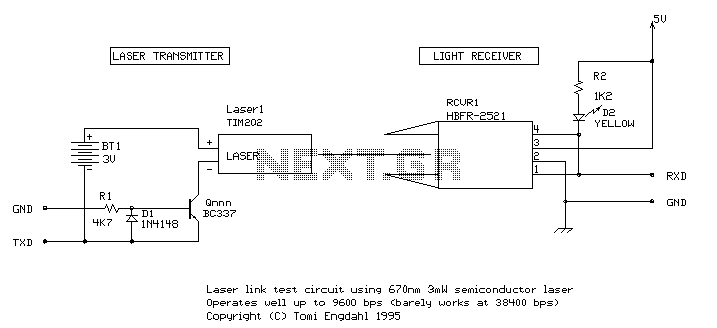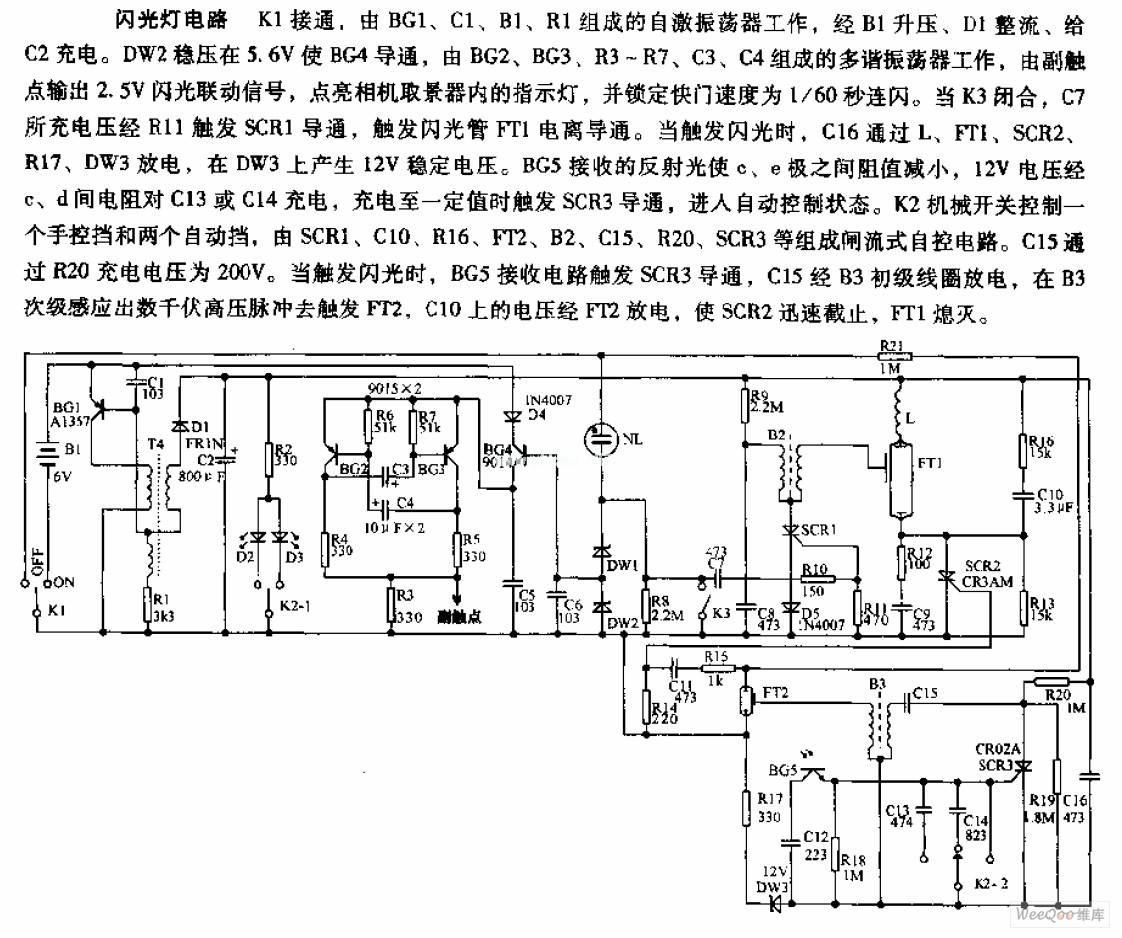
Photo Meter Assesses Ambient Light Schematic

Most PN-junction diodes can be utilized as photodiodes. Although they are not specifically optimized for this purpose, they are functional. When reverse biased, a diode generates a small photovoltaic output that increases with light intensity. Light Emitting Diodes (LEDs) are particularly suitable for this application due to their transparent housings. A simple circuit can be constructed to evaluate ambient lighting conditions and, due to the tinted packages of many LEDs designed to enhance emitted colors, it may also provide a reasonable assessment of the detected color. Although the results may not be as effective as those obtained with high-quality optical filters that possess narrow bandpass characteristics, they can still be acceptable. The design described here may not achieve the accuracy of setups using laboratory-grade photodetectors and transimpedance amplifiers, but it can be assembled quickly and yield usable results at a low cost. The circuit employs three LEDs, and experimentation will help identify which LED is most sensitive to specific colors. The ambient light incident on the LEDs generates a small current, typically ranging from 10 to 100 nA, depending on the illumination level. This current flows into the base of a transistor (Q1), where it is amplified. The collector current of Q1 is then divided between a potentiometer (R4), which serves as the first stage of gain calibration, and the base of a second transistor (Q2). Q2 further amplifies the signal and drives one side of a bridge circuit composed of diodes D1A and D1B. It is important to note that resistors R2/D1 and R3/D2 create a balanced bridge configuration. The collector current from Q2 introduces a slight imbalance to the bridge, which is measured by a meter (M). Resistor R5 adjusts the sensitivity of the meter. Both R4 and R5 should be set to achieve an appropriate deflection on the meter, with R4 allowing for selection of the quiescent point and R5 enabling sensitivity adjustments. Prior to circuit assembly, it is advisable to verify the suitability of the LEDs as photodetectors. To assess whether a specific LED functions well as a photodiode, measure the voltage across it using a digital multimeter set to its most sensitive range, typically 200 mV. The expected output voltage under standard office lighting conditions should be approximately 0.3 to 1 mV.
The described circuit leverages the properties of PN-junction diodes and LEDs for ambient light detection and color evaluation. The fundamental operation begins with the reverse biasing of the LED, which allows it to function as a photodiode. The small photocurrent generated by the LED in response to ambient light is critical for the circuit's operation. The choice of three different LEDs allows for a comparative analysis of their sensitivity to various wavelengths of light, enabling the circuit to discern different colors based on the varying responses of the LEDs.
The use of transistors Q1 and Q2 for signal amplification is essential for enhancing the weak signals generated by the LEDs. The first transistor (Q1) amplifies the photocurrent, and its collector current is split into two paths: one through the potentiometer R4 for gain calibration, and the other to the base of the second transistor (Q2) for further amplification. The bridge circuit formed by D1A and D1B provides a means to measure the output imbalance caused by Q2's collector current, which is indicative of the light intensity and color detected by the LEDs.
The inclusion of variable resistors R4 and R5 allows for fine-tuning of the circuit's sensitivity and calibration, making it adaptable to different lighting conditions and requirements. The circuit's simplicity and low-cost components make it an accessible option for applications in ambient light sensing and color detection, suitable for educational purposes or basic environmental monitoring. The practical approach of using off-the-shelf LEDs, combined with straightforward amplification and measurement techniques, results in a functional device capable of providing valuable insights into ambient lighting conditions.Most PN-junction diodes can be used as photodiodes. While not optimized for this application, they do work. When the diode is reverse biased, it will produce a small photovoltaic output as the light level is increased. LEDs are particularly suited for this task because their housings are transparent. You can construct a simple circuit that will assess the condition of ambient lighting and, because many LEDs` packages are tinted to enhance their emitted color, may even yield a reasonable evaluation of the detected color. The results are not as effective as those obtained using a high-quality optical filter, which typically has narrow bandpass characteristics, but they can be quite acceptable.
Though the design described here does not produce the accuracy of designs with laboratory-grade photodetectors and transimpedance amplifiers, it can be quickly assembled and will produce usable results at a low cost. Three LEDs are used; experimentation will indicate which device has the best sensitivity to which color (Figure 1).
The ambient light falling on the LEDs causes some current flow ”typically in the range of 10 to 100 nA ”through each LED, depending on the applied illumination level. This current flows through the base of a transistor, Q1, and is amplified. Q1`s collector current then splits between potentiometer R4, which acts as a first-stage gain calibration, and the base of Q2.
Q2 provides further amplification and drives the left side of a bridge circuit (D1A and D1B). Note that R2/D1 and R3/D2 form a balanced bridge. Q2`s collector current provides a slight imbalance to the bridge. The meter, M, measures this imbalance. R5 adjusts the sensitivity of the meter. Set R4 and R5 such that the meter has an appropriate deflection. R4 is useful for selecting the quiescent point; R5 is useful for adjusting the sensitivity. Before building the circuit, check whether the LEDs can be used as photo sensors. To determine whether a given LED is a good photodiode, check the voltage across the LED using a common digital multimeter set to its most sensitive range ”typically 200 mV. Typical output voltage should be approximately 0. 3 to 1 mV with typical office illumination. 🔗 External reference
The described circuit leverages the properties of PN-junction diodes and LEDs for ambient light detection and color evaluation. The fundamental operation begins with the reverse biasing of the LED, which allows it to function as a photodiode. The small photocurrent generated by the LED in response to ambient light is critical for the circuit's operation. The choice of three different LEDs allows for a comparative analysis of their sensitivity to various wavelengths of light, enabling the circuit to discern different colors based on the varying responses of the LEDs.
The use of transistors Q1 and Q2 for signal amplification is essential for enhancing the weak signals generated by the LEDs. The first transistor (Q1) amplifies the photocurrent, and its collector current is split into two paths: one through the potentiometer R4 for gain calibration, and the other to the base of the second transistor (Q2) for further amplification. The bridge circuit formed by D1A and D1B provides a means to measure the output imbalance caused by Q2's collector current, which is indicative of the light intensity and color detected by the LEDs.
The inclusion of variable resistors R4 and R5 allows for fine-tuning of the circuit's sensitivity and calibration, making it adaptable to different lighting conditions and requirements. The circuit's simplicity and low-cost components make it an accessible option for applications in ambient light sensing and color detection, suitable for educational purposes or basic environmental monitoring. The practical approach of using off-the-shelf LEDs, combined with straightforward amplification and measurement techniques, results in a functional device capable of providing valuable insights into ambient lighting conditions.Most PN-junction diodes can be used as photodiodes. While not optimized for this application, they do work. When the diode is reverse biased, it will produce a small photovoltaic output as the light level is increased. LEDs are particularly suited for this task because their housings are transparent. You can construct a simple circuit that will assess the condition of ambient lighting and, because many LEDs` packages are tinted to enhance their emitted color, may even yield a reasonable evaluation of the detected color. The results are not as effective as those obtained using a high-quality optical filter, which typically has narrow bandpass characteristics, but they can be quite acceptable.
Though the design described here does not produce the accuracy of designs with laboratory-grade photodetectors and transimpedance amplifiers, it can be quickly assembled and will produce usable results at a low cost. Three LEDs are used; experimentation will indicate which device has the best sensitivity to which color (Figure 1).
The ambient light falling on the LEDs causes some current flow ”typically in the range of 10 to 100 nA ”through each LED, depending on the applied illumination level. This current flows through the base of a transistor, Q1, and is amplified. Q1`s collector current then splits between potentiometer R4, which acts as a first-stage gain calibration, and the base of Q2.
Q2 provides further amplification and drives the left side of a bridge circuit (D1A and D1B). Note that R2/D1 and R3/D2 form a balanced bridge. Q2`s collector current provides a slight imbalance to the bridge. The meter, M, measures this imbalance. R5 adjusts the sensitivity of the meter. Set R4 and R5 such that the meter has an appropriate deflection. R4 is useful for selecting the quiescent point; R5 is useful for adjusting the sensitivity. Before building the circuit, check whether the LEDs can be used as photo sensors. To determine whether a given LED is a good photodiode, check the voltage across the LED using a common digital multimeter set to its most sensitive range ”typically 200 mV. Typical output voltage should be approximately 0. 3 to 1 mV with typical office illumination. 🔗 External reference





